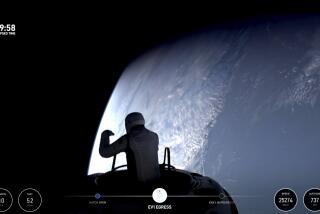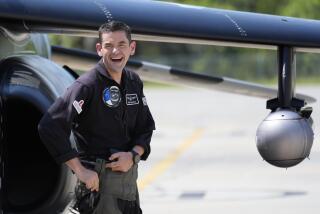Biggest Space Crew Soars Aloft : 2 W. Germans, Dutchman Part of Spacelab Team
- Share via
CAPE CANAVERAL, Fla. — Five Americans, two West Germans and a Dutchman, the largest space crew ever, rode the shuttle Challenger into orbit today for a week of round-the-clock research in a workshop crammed with furnaces, biological chambers, a garden and a one-man sled on rails.
The 100-ton spaceplane rumbled spectacularly off its launch pad right on schedule at noon (9 a.m. PST) to start the 22nd shuttle mission, the ninth for the veteran Challenger. A tail of fire 700 feet long trailed the shuttle as it darted into a sunny sky high over the Atlantic Ocean on a northeast heading.
Nine minutes later, Mission Control Center in Houston reported that Challenger was in a secure orbit more than 200 miles high.
Among the dignitaries who viewed the launching were Princess Margriet of the Netherlands; Guenther van Well, the West German ambassador to the United States; Christa McAuliffe of Concord, N.H., who will be the first teacher in space on a January shuttle flight, and 91-year-old Hermann Oberth of West Germany, one of the world’s early rocket pioneers.
Seventy-six experiments are in the European-built Spacelab, a 23-foot-long pressurized laboratory mounted in the ship’s cargo bay.
Most of the experiments are West German, and the Federal German Aerospace Establishment is paying the National Aeronautics and Space Administration $64 million to ferry them into orbit. The control center for the experiments is in Oberpfaffenhofen, near Munich, marking the first time that a foreign country will control a shuttle payload during flight.
‘A Major Milestone’
“The scientific goal is to acquire interesting results in materials processing, the life sciences, biology and navigation in the absence of gravity,” said Ernst Messerschmid, one of the German astronauts. “But it also will demonstrate that we in Germany can handle all the data in our own operations control center.”
Reinhard Furrer, the other German, said: “It is a major milestone leading to future cooperation among nations in space. It will get us ready on all levels for projects like the U.S. space station.”
The 10-nation European Space Agency has several experiments aboard the flight and selected the Dutch astronaut, Wubbo Ockels, to oversee them in space.
The Americans in the crew are Henry Hartsfield, veteran of two earlier shuttle flights, Steven Nagel, Bonnie Dunbar, Guion Bluford and James Buchli.
The lab has furnaces for melting and mixing materials and growing crystals, a small botanical garden, a sealed-glove chamber for working with biological materials and a container where the growth of frog eggs will be monitored.
Mounted on the Spacelab floor are two 12-foot parallel rails on which a one-seat space sled driven by an electric motor will be used by crew members for tests that may shed light on why a large percentage of shuttle astronauts have suffered motion sickness early in weightless flight.
More to Read
Sign up for Essential California
The most important California stories and recommendations in your inbox every morning.
You may occasionally receive promotional content from the Los Angeles Times.










